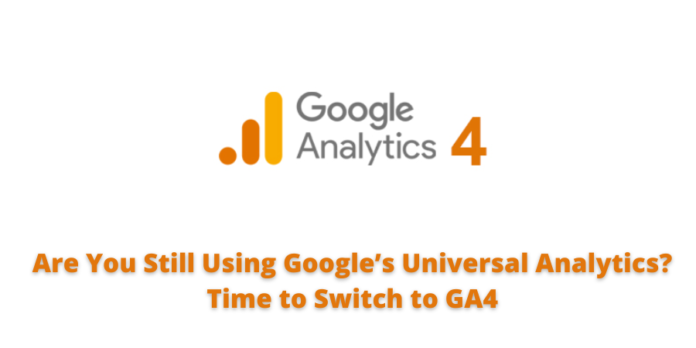Search engine optimization (SEO) is the crux of digital marketing. Businesses have realized the importance of SEO in getting more traffic, creating a digital presence, and boosting profits. Thus, companies widely adopt the best SEO software to stay ahead of the competition and grow their business. Studies suggest that the global search engine optimization (SEO) software market will reach USD 1.6 billion by 2027.
Google’s Universal Analytics tools have been the top player worldwide among the best SEO tools. These help businesses track and enhance their SEO performance and thus improve overall business performance. Global surveys indicate that among the websites whose traffic analysis tool is known (around 55.7% of all websites), Google Analytics is used by 85.9% of the websites.

Google Analytics is rapidly improving to accommodate increasing business analytics needs. It is now power-packed with new features, advanced tools, and artificial intelligence-based insights with its latest version, GA4. Let’s see how GA4 will revolutionize business analytics and take it to the next level.
Why GA4 Is the Future of Business Analytics?
GA4 is the future of business analytics with its numerous helpful and innovative tools. Here are the top offerings of GA4 that businesses must leverage for enhanced business analytics.
Artificial Intelligence (AI) Insights
The AI-based intelligence insights/analytics feature of GA4 offers numerous suggested questions that SEO analysts can leverage. It also allows analysts to type directly into the search bar for other questions or insights.
GA4 AI insights enable automated and custom insights. The automated insights include basic site performance metrics, including the number of new users in the last week, top pages & screens by the number of views, days with the highest users, top events by the users, and more. It enables viewing detailed demographic data for where the users come from, top countries by revenue, top cities, and languages users use the most. Additionally, analysts can get user acquisition insights, the number of users from organic search, a comparison of revenues, users from paid search vs. organic search, detailed traffic analysis for monthly users, and growth in users month-over-month.
GA4 allows users to easily create custom insights by setting conditions to generate these insights, including evaluation frequency, user segment (including or excluding various segments), and specific conditions. To get the required custom insight, users need to simply define three parameters, the metric, condition, and value for the insight. Moreover, the users get an extensive view of all these triggered insights on the insights dashboard, and they can choose to get this notified by email.
Besides, GA4 offers predictive analytics and custom reports for prospective purchasers, churning users, mobile traffic, and more based on historical data.
User Engagement and Retention
GA4 offers broader user engagement and retention metrics. It enables businesses to comprehensively analyze average engagement time, engaged sessions per user, average engagement time per session, and user engagement from different devices, operating systems, and browsers.
Moreover, to assess user engagement by demographics, GA4 offers users engagement by country, highlighting top locations/countries of user engagement. Analyzing the user engagement from a specific target location/country helps businesses focus on improving engagement for that location. Analysts can also get comprehensive user retention, new users, and returning users analytics in GA4. Besides, it allows choosing the duration for these analytics, for example, over the last 7 days, 28 days, and 90 days.
GA4 facilitates in-depth analytics on the customer life cycle or user journey through three identifiers, user ID, Google signals, and device ID, collectively called identity spaces. This GA4 feature helps measure users across devices and platforms. It enables detailed user segmentation, enhanced cross-device insights, and user trends analysis over 7, 28, and 90 days.
Extensive Events Tracking
Visitors perform numerous activities on the website or app, including viewing the page, clicking on links or buttons, scrolling through, downloading files, etc. These activities or events provide remarkable insights to businesses and help them improve user engagement, conversions, and overall performance. Google Analytics 4 allows SEO analysts to quickly and comprehensively track numerous such events more efficiently than the previous versions of GA.
GA4 allows tracking of automatically collected, recommended, and custom events. The automatically collected events include session_start, first_visit, and user_engagement. Other prominent GA4 events are page_view, scroll, click, view_search_results, file_download, and YouTube video engagement events, including video_start, video_progress, and video_complete. GA4 allows analysts to create and track up to 300 events per property.
Google Ads – Enhanced Integration
Google Ads have numerous benefits for businesses. It enables them to improve online leads, earn more conversions, enhance sales, maximize ROI (return on investment), and create brand awareness.
GA4 allows enhanced integration with Google Ads. It helps businesses link their Google Ads account to the analytics property to get an enhanced view of the entire customer cycle, how users interact (clicking ads, etc.), and what activities the customers perform on the business site or app (making purchases, etc.).
Anomaly Detection
Anomaly detection is another vital piece of information crucial for every business. It helps identify critical incidents, potential opportunities, technical faults, a spike in traffic, sudden changes in customer behavior or trends, and more. Catching such anomalies at the right time enables better planning, decision-making, and enhanced security.
GA4 leverages AI for anomaly detection. It uses historical data to predict the value of various metrics for the specified time period. When the actual value falls beyond the credible interval, it points out the value as an anomaly that requires attention. Moreover, GA4 detects anomalies in time-series data for a given metric and anomalies within a segment at the same point in time.
Other Offerings
Apart from the above offerings, GA4 enables numerous innovative data controls, enhanced security, automated & customized tables, creating upto 30 conversions per property, provision to delete the conversions that are no longer needed, behavioral modeling with consent mode, and much more.
Wrapping Up
No matter how good your business website, portal, or app is, without analyzing its performance and gradually enhancing it, you cannot survive in the competitive market. Businesses have been using SEO analytics for over a decade, but Google Analytics has always been a global leader in SEO tools.
GA is now a step ahead to offer more convenience and better tools to enhance performance analytics for businesses by launching GA4. We have shared some insights on how to leverage GA4 for your business. Adopt GA4 now for assured business success.
Author Bio
Jason Adams is a writer with a keen interest to continue learning and develop his research abilities. An avid reader and an eye toward growth, he is associated with GoodFirms, a frontline, and evolving reviews and rating platform.


















